so here is my rankings of the top five survival knives.
the requirements- they have to be found under one hundred dollars, and the blade length has to be about seven inches and under. They also have to be fixed blade knives to provide strength, and all of these blades are very adequate for a survival situation that needs some strength in the blade.
#5- the Buck 119 Special Fixed Blade Knife
This knife has gotten many good reviews and I have only used it a couple of times but I really like it. what really stands out to me in this knife was the price. I found it for $46 on Amazon.com. that's a deal. the blade design is such that it can be used for skinning and whittling, but it probably has trouble cutting rope due to the lack of serrations on the blade. the handle looks very nice, but due to it's material it probably could slip out of your hands alot more easily than some other survival knives when your hands are wet or covered with blood. also, the sheath is just a plain leather sheath that is not very safe compared to tougher ones, and a fall could shove the knife easily through it from what i could tell. for that i put it on the fifth spot on my list for the top five survival knives.
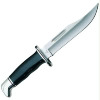
#4- the Ka-Bar Next Generation Fighting Knife
The classic USMC purposed designed knife is fourth on my list. It's updated version is quite awesome. at the top end of our blade length requirements, It can be somewhat bulky to carry around but the blade length comes in handy when bigger jobs are needed. the serrations provide good cutting action on synthetic materials, as well as of course, rope. the powder coating repels rust, and the 440a steel is quite good. But, there are a few downsides to this knife. It's HEAVY. compared to the next knives on my list, it is like a brick. but I think that the classic design of this knife with the few flaws fixed from the older design does well at placing this knife at #4.
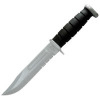
#3- The Cold Steel 38CK SRK Survival Knife
I thought i had to throw a cold steel knife in here for all you cold steel folks, and i found one that fits a survivalist's needs. The Cold Steel SRK survival knife is a very pretty, durable, and comfortable knife. at about 71 dollars on Amazon, it's not cheap, but the overall design is worth it. with a finger guard that only extends out the bottom, you can choke up on the blade spine to do more careful workings on wood or skinning of some sort. the handle is made of a rubberized type substance, and looks to be a very good quality especially for gripping when your hands are wet. now the downsides of rubber is that when in cold conditions rubber tends to do some weird things, and rubber can be cut quite easily compared to harder plastics. but, the blade is made of an AUS-8 steel and will do fine for all sorts of jobs needed for a knife. the coating is good, a black powder epoxy coat, which helps with rust, and the straighter edge can do things that some curvier blades cannot. the sheath is Cold Steels secure Ex-sheath, which i have heard good things about. But, this blade lacks serrations, which you want in a survival knife. so this knife goes to the #3 slot on my list.
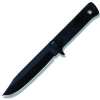
#2- The Gerber LMF 2 Infantry knife
I have heard many good things about this knife, and I have also used it on occasion in the past. this is one good knife. Many swear by it, and for good reason. this knife has serrations, a black coating, and a good shape. The handle sports three holes, so it can be lashed to a stick with shoelaces to make a spear. the end cap is a strong stainless steel and is pointed so it can peirce glass with no problems. the handle has some sort of an insulation to protect against electric shock when cutting live wires (military purpose). The sheath has a built in sharpener, and is MOLLE capable. the only downsides to this knife is the lack of extra texture in the handle to help you grip the knife in wet conditions, the price is a hefty seventy five dollars on Amazon, the weight of this knife is about 11.4 ounces, and the sheath does not have add-on capabilities for a multi-tool or some other tool, which my #1 Knife does include.
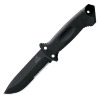
#1- The SOG SEAL pup knife
I placed this knife at the top of my list because of the huge battery of tests that SOG placed it through to give it it's name. they submerged this knife under saltwater for three days then let it sit out in the air to dry off on it's own and it did not rust. the SEAL pup knife weighs a feather 5.4 oz, and you hardly know its there when you are carrying it. The AUS 6 special powder coated blade will do all sorts of tasks, because of the nice serrations about a quarter of the way down the blade it can cut through rope very easily and the curved end can whittle on wood like it's soap. the super textured but non-blistering handle made of Zytel is very very durable and will not slip out of your hand when wet at all. speaking of wet, the powder coating on this blade will just bead water off of it like it's no problem. you can get this knife in an elite version, which has a thicker blade and has notches on top of the spine a good way down the blade. also comes in straight edge. this knife is extremely sharp, and I have cut myself with it once already.
It comes with two types of sheaths, one is a smaller lighter kydex with a notch in the sheath so you can cut small rope with it while it's in the sheath. the Nylon sheath has kydex inside of it, and has a pocket on the outside for a multi-tool or a magnesium fire starter, and is MOLLE capable as well. The velcro and buttton tie down for the knife while it's in the sheath makes it near impossible to get this thing to come out of the sheath without undoing it. the raised spine in two places makes it possible for me to choke up on the blade to do some more precise work. IMHO, this is the best survival knife out there, and the cheapest on our list below the buck, at $54 on amazon. (cant get much better then that) The name says it all.
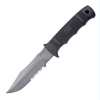
This list is just my opinion. some may disagree with it, some may not, but take the information and use it, because it is very helpful.
So, let me ask, what is your top five survival and outdoor knives?
the requirements- they have to be found under one hundred dollars, and the blade length has to be about seven inches and under. They also have to be fixed blade knives to provide strength, and all of these blades are very adequate for a survival situation that needs some strength in the blade.
#5- the Buck 119 Special Fixed Blade Knife
This knife has gotten many good reviews and I have only used it a couple of times but I really like it. what really stands out to me in this knife was the price. I found it for $46 on Amazon.com. that's a deal. the blade design is such that it can be used for skinning and whittling, but it probably has trouble cutting rope due to the lack of serrations on the blade. the handle looks very nice, but due to it's material it probably could slip out of your hands alot more easily than some other survival knives when your hands are wet or covered with blood. also, the sheath is just a plain leather sheath that is not very safe compared to tougher ones, and a fall could shove the knife easily through it from what i could tell. for that i put it on the fifth spot on my list for the top five survival knives.

#4- the Ka-Bar Next Generation Fighting Knife
The classic USMC purposed designed knife is fourth on my list. It's updated version is quite awesome. at the top end of our blade length requirements, It can be somewhat bulky to carry around but the blade length comes in handy when bigger jobs are needed. the serrations provide good cutting action on synthetic materials, as well as of course, rope. the powder coating repels rust, and the 440a steel is quite good. But, there are a few downsides to this knife. It's HEAVY. compared to the next knives on my list, it is like a brick. but I think that the classic design of this knife with the few flaws fixed from the older design does well at placing this knife at #4.

#3- The Cold Steel 38CK SRK Survival Knife
I thought i had to throw a cold steel knife in here for all you cold steel folks, and i found one that fits a survivalist's needs. The Cold Steel SRK survival knife is a very pretty, durable, and comfortable knife. at about 71 dollars on Amazon, it's not cheap, but the overall design is worth it. with a finger guard that only extends out the bottom, you can choke up on the blade spine to do more careful workings on wood or skinning of some sort. the handle is made of a rubberized type substance, and looks to be a very good quality especially for gripping when your hands are wet. now the downsides of rubber is that when in cold conditions rubber tends to do some weird things, and rubber can be cut quite easily compared to harder plastics. but, the blade is made of an AUS-8 steel and will do fine for all sorts of jobs needed for a knife. the coating is good, a black powder epoxy coat, which helps with rust, and the straighter edge can do things that some curvier blades cannot. the sheath is Cold Steels secure Ex-sheath, which i have heard good things about. But, this blade lacks serrations, which you want in a survival knife. so this knife goes to the #3 slot on my list.

#2- The Gerber LMF 2 Infantry knife
I have heard many good things about this knife, and I have also used it on occasion in the past. this is one good knife. Many swear by it, and for good reason. this knife has serrations, a black coating, and a good shape. The handle sports three holes, so it can be lashed to a stick with shoelaces to make a spear. the end cap is a strong stainless steel and is pointed so it can peirce glass with no problems. the handle has some sort of an insulation to protect against electric shock when cutting live wires (military purpose). The sheath has a built in sharpener, and is MOLLE capable. the only downsides to this knife is the lack of extra texture in the handle to help you grip the knife in wet conditions, the price is a hefty seventy five dollars on Amazon, the weight of this knife is about 11.4 ounces, and the sheath does not have add-on capabilities for a multi-tool or some other tool, which my #1 Knife does include.

#1- The SOG SEAL pup knife
I placed this knife at the top of my list because of the huge battery of tests that SOG placed it through to give it it's name. they submerged this knife under saltwater for three days then let it sit out in the air to dry off on it's own and it did not rust. the SEAL pup knife weighs a feather 5.4 oz, and you hardly know its there when you are carrying it. The AUS 6 special powder coated blade will do all sorts of tasks, because of the nice serrations about a quarter of the way down the blade it can cut through rope very easily and the curved end can whittle on wood like it's soap. the super textured but non-blistering handle made of Zytel is very very durable and will not slip out of your hand when wet at all. speaking of wet, the powder coating on this blade will just bead water off of it like it's no problem. you can get this knife in an elite version, which has a thicker blade and has notches on top of the spine a good way down the blade. also comes in straight edge. this knife is extremely sharp, and I have cut myself with it once already.
It comes with two types of sheaths, one is a smaller lighter kydex with a notch in the sheath so you can cut small rope with it while it's in the sheath. the Nylon sheath has kydex inside of it, and has a pocket on the outside for a multi-tool or a magnesium fire starter, and is MOLLE capable as well. The velcro and buttton tie down for the knife while it's in the sheath makes it near impossible to get this thing to come out of the sheath without undoing it. the raised spine in two places makes it possible for me to choke up on the blade to do some more precise work. IMHO, this is the best survival knife out there, and the cheapest on our list below the buck, at $54 on amazon. (cant get much better then that) The name says it all.

This list is just my opinion. some may disagree with it, some may not, but take the information and use it, because it is very helpful.
So, let me ask, what is your top five survival and outdoor knives?
Last edited:












